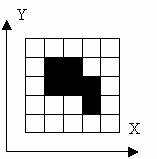1008. Image encoding
Memory Limit: 16 MB

2 3
2 4
3 3
3 4
4 2
4 3
RT,
RT,
,
B,
,
.
Input
Output
Sample
| input | output |
|---|---|
|
6 2 3 2 4 3 3 3 4 4 2 4 3 |
2 3 RT, RT, , B, , . |
解答如下:
2 using System.IO;
3 using System.Drawing;
4 using System.Collections.Generic;
5
6 namespace Skyiv.Ben.Timus
7 {
8 // http://acm.timus.ru/problem.aspx?space=1&num=1008
9 sealed class T1008
10 {
11 static readonly Size[] direction = { new Size(1,0), new Size(0,1), new Size(-1,0), new Size(0,-1) };
12 static readonly string letter = "RTLB"; // Right, Top, Left, Bottom
13 bool[,] image = new bool[12, 12];
14
15 static void Main()
16 {
17 new T1008().Run(Console.In, Console.Out);
18 }
19
20 void Run(TextReader reader, TextWriter writer)
21 {
22 string[] ss = reader.ReadLine().Split();
23 if (ss.Length < 2) Write2(writer, Read1(reader, int.Parse(ss[0])));
24 else Write1(writer, Read2(reader, new Point(int.Parse(ss[0]), int.Parse(ss[1]))));
25 }
26
27 Point Read1(TextReader reader, int lines)
28 {
29 Point first = Point.Empty;
30 for (int i = 0; i < lines; i++)
31 {
32 string[] ss = reader.ReadLine().Split();
33 Point p = new Point(int.Parse(ss[0]), int.Parse(ss[1]));
34 image[p.X, p.Y] = true;
35 if (i == 0) first = p;
36 }
37 return first;
38 }
39
40 void Write1(TextWriter writer, int cnt)
41 {
42 writer.WriteLine(cnt);
43 for (int i = 0; i < image.GetLength(0); i++)
44 for (int j = 0; j < image.GetLength(1); j++)
45 if (image[i, j]) writer.WriteLine(i + " " + j);
46 }
47
48 int Read2(TextReader reader, Point first)
49 {
50 int cnt = 1;
51 image[first.X, first.Y] = true;
52 Queue<Point> queue = new Queue<Point>();
53 queue.Enqueue(first);
54 while (queue.Count > 0)
55 {
56 Point p, q = queue.Dequeue();
57 string s = reader.ReadLine();
58 for (int idx, i = 0; ; i++, cnt++)
59 {
60 if ((idx = letter.IndexOf(s[i])) < 0) break;
61 queue.Enqueue(p = q + direction[idx]);
62 image[p.X, p.Y] = true;
63 }
64 }
65 return cnt;
66 }
67
68 void Write2(TextWriter writer, Point first)
69 {
70 writer.WriteLine(first.X + " " + first.Y);
71 image[first.X, first.Y] = false;
72 Queue<Point> queue = new Queue<Point>();
73 queue.Enqueue(first);
74 while (queue.Count > 0)
75 {
76 Point q = queue.Dequeue();
77 for (int i = 0; i < direction.Length; i++)
78 {
79 Point p = q + direction[i];
80 if (!image[p.X, p.Y]) continue;
81 queue.Enqueue(p);
82 image[p.X, p.Y] = false;
83 writer.Write(letter[i]);
84 }
85 writer.WriteLine((queue.Count > 0) ? "," : ".");
86 }
87 }
88 }
89 }
这道题目讨论的黑白图像至少包含一个黑色象素,且所有的黑色像素都是连通的。我们考虑两种对黑色象素进行编码的方案。
第一种编码方案在第一行给出黑色象素的数目,在接下来的行中给出黑色象素的坐标,该坐标是排好序的。
第二种编码方案在第一行中给出左下角黑色象素的坐标。接下来的行依次描述每个黑色象素的邻居,每个邻居用一个英文字母表示:R:右、T:顶、L:左、B:底,已经描述过的邻居不再描述,每一行以逗号结束,最后一行以句号结束。
现在给出某幅黑白图像的一种编码,要求你写一个程序输出该图像的另一种编码。
在上述程序中,第 13 行的布尔矩阵 image 用来在内存中表示该黑白图像。
第 20 到 25 行的 Run 方法根据输入的第一行判断该黑白图像是采用哪种方案编码的,然后调用相应的方法进行处理。
第 27 到 38 行的 Read1 方法读取第一种编码方案的输入到 image 矩阵中,并返回该黑白图像左下角黑色象素的坐标。
第 40 到 46 行的 Write1 方法将 image 矩阵按第一种编码方案输出,其中 cnt 表示黑色象素的数目。
第 48 到 66 行的 Read2 方法读取第二种编码方案的输入到 image 矩阵中,并返回该黑白图像中黑色象素的数目。第 52 行的 queue 队列用来记录黑色象素的坐标。第 54 行开始的循环依次读入各个黑色象素。
第 68 到 87 行的 Write2 方法将 image 矩阵按第二种编码方案输出,其中 first 表示该黑白图像左下角黑色象素的坐标。第 72 行的 queue 队列用来记录黑色象素的坐标。第 74行开始的循环使用广度优先搜索算法来寻找黑色象素。
返回目录






【推荐】国内首个AI IDE,深度理解中文开发场景,立即下载体验Trae
【推荐】编程新体验,更懂你的AI,立即体验豆包MarsCode编程助手
【推荐】抖音旗下AI助手豆包,你的智能百科全书,全免费不限次数
【推荐】轻量又高性能的 SSH 工具 IShell:AI 加持,快人一步
· 如何编写易于单元测试的代码
· 10年+ .NET Coder 心语,封装的思维:从隐藏、稳定开始理解其本质意义
· .NET Core 中如何实现缓存的预热?
· 从 HTTP 原因短语缺失研究 HTTP/2 和 HTTP/3 的设计差异
· AI与.NET技术实操系列:向量存储与相似性搜索在 .NET 中的实现
· 周边上新:园子的第一款马克杯温暖上架
· Open-Sora 2.0 重磅开源!
· 分享 3 个 .NET 开源的文件压缩处理库,助力快速实现文件压缩解压功能!
· Ollama——大语言模型本地部署的极速利器
· [AI/GPT/综述] AI Agent的设计模式综述